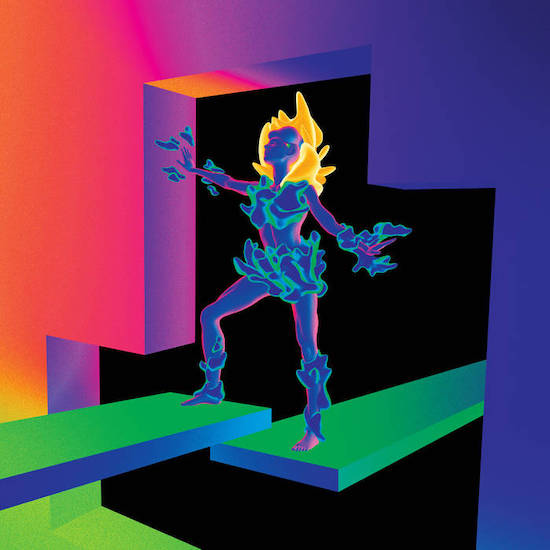Kaitlyn Aurelia Smith is dancing in an eye-scorching tumble of neon bricks and video game aesthetics. Her physical movements have been tracked via a motion capture suit and used to generate a 3D avatar of herself. It’s a hyperreal world that merges her new album’s sound palette and the 3D-generated visual landscapes that make up the accompanying music videos and the record’s sleeve artwork featuring her body wrapped in heat-sensitive armour, her hair and her left arm gloriously aflame.
Let’s Turn It Into Sound is hot and fiery in one moment; cold and distanced the next. Reference points pop up and are batted away. Jazzy beginnings merge with New Age sighs and oscillating twinkles. She never sits still for long, eagerly moving on to the next iteration. There’s ping-ponging glockenspiel hits, dragged metallic bass lines, corrugated chiptune, cosmic jazz, writhing hip-hop drums, choral swells, cautious ambient pulsing, emotive war cries, modern classical sweeps, tumbling broken beats, judder-snatched vocal snippets, and syncopated synth sequences that sound like amphibians hopping from fizzing electric lily pad to fizzing electric lily pad. It’s not just a mongrel mesh of genres. It’s stretching and cracking them into new shapes, creating something fresh, hyperactive, and utterly pop.
Smith’s vocals sometimes guide, sometimes mislead like a mischievous imp. Her voice is warped, reversed, squished and splatted. It’s a waterfall that flows in many directions at once. Occasionally it is the cascading water, at other times a salmon leaping against the current, and, rarer still, the bear snatching the salmon nosing its way upstream. ‘There Is Something’ frames her vocal’s affecting self-harmonisation as if a text-to-speech bot has been shackled to Cher’s ‘Believe’ auto-tune. Whilst closer ‘Give To The Water’ pushes these manipulations to its limits, her voice becoming as sonorous as her earlier, more contemplative, drone work.
There’s definitely the sense, between the Buchla-centered carousel of sound and the mystifying visual accompaniments, that something deeper is occurring. And peering beyond the overwhelming genre switches and maximalist psychedelia, it seems that the heart beating at the centre of the record is more about human connection than the surface level technical wizardry might suggest.
Similarly to J Dilla’s Donuts, Let’s Turn It Into Sound flits from one engrossing segment to another, not daring to let a single bar outstay its welcome. There are flashes of gold here, there, and everywhere. Compositions that other artists might latch on to and stretch out for an entire career vanish in the blink of an eye. Unceasing waves of new sounds persistently rain down like the aliens in Space Invaders to the point of utter saturation.
Initially this might seem vexing, akin to the work of a mind battling attention disorders, but repeated listens reveal the joy in such intermittent encounters with these brief sonic acquaintances. It becomes clear that this is not so much a scattergun approach as an artist with their arms wide open. Smith has bravely let her defences down and encourages us to do the same. To embrace everything, from the known to the unknown, and to let ourselves be just a little bit vulnerable.
After all, in this hyperpop video game of an album, forged out of neon bricks, sparking frogs, and flaming limbs, there’s bound to be a continue or two left if it all goes horribly wrong. One more power up after it all comes tumbling down.


